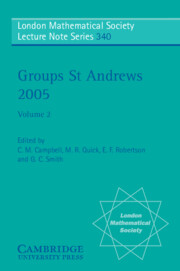Book contents
- Frontmatter
- Contents
- Introduction
- 1 Groups and semigroups: connections and contrasts
- 2 Toward the classification of s-arc transitive graphs
- 3 Non-cancellation group computation for some finitely generated nilpotent groups
- 4 Permutation and quasi-permutation representations of the Chevalley groups
- 5 The shape of solvable groups with odd order
- 6 Embedding in finitely presented lattice-ordered groups: explicit presentations for constructions
- 7 A note on abelian subgroups of p-groups
- 8 On kernel flatness
- 9 On proofs in finitely presented groups
- 10 Computing with 4-Engel groups
- 11 On the size of the commutator subgroup in finite groups
- 12 Groups of infinite matrices
- 13 Triply factorised groups and nearrings
- 14 On the space of cyclic trigonal Riemann surfaces of genus 4
- 15 On simple Kn-groups for n = 5, 6
- 16 Products of Sylow subgroups and the solvable radical
- 17 On commutators in groups
- 18 Inequalities for the Baer invariant of finite groups
- 19 Automorphisms with centralizers of small rank
- 20 2-signalizers and normalizers of Sylow 2-subgroups in finite simple groups
- 21 On properties of abnormal and pronormal subgroups in some infinite groups
- 22 P-localizing group extensions
- 23 On the n-covers of exceptional groups of Lie type
- 24 Positively discriminating groups
- 25 Automorphism groups of some chemical graphs
- 26 On c-normal subgroups of some classes of finite groups
- 27 Fong characters and their fields of values
- 28 Arithmetical properties of finite groups
- 29 On prefrattini subgroups of finite groups: a survey
- 30 Frattini extensions and class field theory
- 31 The nilpotency class of groups with fixed point free automorphisms of prime order
24 - Positively discriminating groups
Published online by Cambridge University Press: 20 April 2010
- Frontmatter
- Contents
- Introduction
- 1 Groups and semigroups: connections and contrasts
- 2 Toward the classification of s-arc transitive graphs
- 3 Non-cancellation group computation for some finitely generated nilpotent groups
- 4 Permutation and quasi-permutation representations of the Chevalley groups
- 5 The shape of solvable groups with odd order
- 6 Embedding in finitely presented lattice-ordered groups: explicit presentations for constructions
- 7 A note on abelian subgroups of p-groups
- 8 On kernel flatness
- 9 On proofs in finitely presented groups
- 10 Computing with 4-Engel groups
- 11 On the size of the commutator subgroup in finite groups
- 12 Groups of infinite matrices
- 13 Triply factorised groups and nearrings
- 14 On the space of cyclic trigonal Riemann surfaces of genus 4
- 15 On simple Kn-groups for n = 5, 6
- 16 Products of Sylow subgroups and the solvable radical
- 17 On commutators in groups
- 18 Inequalities for the Baer invariant of finite groups
- 19 Automorphisms with centralizers of small rank
- 20 2-signalizers and normalizers of Sylow 2-subgroups in finite simple groups
- 21 On properties of abnormal and pronormal subgroups in some infinite groups
- 22 P-localizing group extensions
- 23 On the n-covers of exceptional groups of Lie type
- 24 Positively discriminating groups
- 25 Automorphism groups of some chemical graphs
- 26 On c-normal subgroups of some classes of finite groups
- 27 Fong characters and their fields of values
- 28 Arithmetical properties of finite groups
- 29 On prefrattini subgroups of finite groups: a survey
- 30 Frattini extensions and class field theory
- 31 The nilpotency class of groups with fixed point free automorphisms of prime order
Summary
Abstract
A group is positively discriminating if any finite subset of positive equations u = v, which are not laws in G, can be simultaneously falsified in G. All known groups which are not positively discriminating satisfy positive laws. The question whether every group without positive laws must be positively discriminating is open. We give an affirmative answer to this question for the class of locally graded groups.
AMS Classification: 20E10 (primary), 20M07 (secondary).
An equation in a group is an expression of the form u = v, where u = u(x1,…,xn), v = v(x1, …, xn) are different words (v may be the empty word 1) in the free group F, freely generated by x1, x2, …. If n = 2, the equation is called binary and we use x, y instead of x1, x2. The equation is called positive if u and v are written without the inverses of the xi's. A positive equation is called balanced if the exponent sum of xi is the same in u and v for each fixed i. A balanced equation u = v is of degree n if the x-length of u and v is equal to n. We say that the n-tuple of elements g1, …, gn in G satisfies the equation u = v, if under the substitution xi → gi we get the equality u(g1, …, gn) = v(g1, …, gn).
Information
- Type
- Chapter
- Information
- Groups St Andrews 2005 , pp. 624 - 629Publisher: Cambridge University PressPrint publication year: 2007
